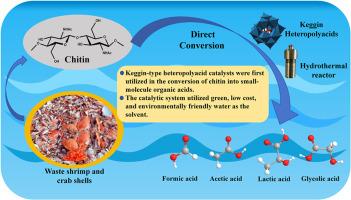水热条件下 Keggin 型杂多酸催化甲壳素生物质可持续生产有机酸。
IF 2.4
3区 化学
Q3 BIOCHEMISTRY & MOLECULAR BIOLOGY
引用次数: 0
摘要
近年来,将贝壳废弃物甲壳素转化为精细化学品的 "贝壳生物炼制 "技术发展迅速。在此,我们提出了一种将甲壳素生物质转化为有机酸的新型无碱杂多酸催化氧化法。经过一系列优化实验,在 180 ℃ 水热条件下,在 0.5 当量的 Mo-V-P 杂多酸(H4PMo11VO40-2H2O)和空气存在下反应 4 小时,甲酸收率为 5.93%,乙酸收率为 25.09%。同时,我们还证明了凯金型杂多酸催化剂能够高效地将微晶甲壳素转化为有机酸。我们利用 FT-IR、XRD、ICP-AES 和 TGA 对合成的杂多酸进行了表征。据此推测了可能的反应途径。该方法具有原料易得、操作简单、产率较高等优点。本文章由计算机程序翻译,如有差异,请以英文原文为准。

Sustainable production of organic acids from chitin biomass catalyzed by Keggin-type heteropolyacid under hydrothermal condition
The “shell biorefinery,” which valorizes the shell waste chitin into fine chemicals, has developed rapidly in recent years. Herein, we present a novel base-free heteropolyacid-catalyzed oxidation method for the transformation of chitin biomass into organic acid. After a series of optimization experiments, a 5.93 % yield of formic acid and 25.09 % yield of acetic acid were achieved in the presence of 0.5 equivalent of Mo–V–P heteropolyacids (H4PMo11VO40·2H2O) and air at 180 °C under hydrothermal conditions for 4 h. Meanwhile, we have demonstrated that the Keggin-type heteropolyacid catalysts are capable of efficiently converting microcrystalline chitin into organic acids. The synthesized heteropolyacids are well characterized with FT-IR, XRD, ICP-AES, and TGA. The possible reaction pathway was speculated accordingly. This method offers several advantages, including readily available raw materials, simple operation, and relatively higher yield.
求助全文
通过发布文献求助,成功后即可免费获取论文全文。
去求助
来源期刊

Carbohydrate Research
化学-生化与分子生物学
CiteScore
5.00
自引率
3.20%
发文量
183
审稿时长
3.6 weeks
期刊介绍:
Carbohydrate Research publishes reports of original research in the following areas of carbohydrate science: action of enzymes, analytical chemistry, biochemistry (biosynthesis, degradation, structural and functional biochemistry, conformation, molecular recognition, enzyme mechanisms, carbohydrate-processing enzymes, including glycosidases and glycosyltransferases), chemical synthesis, isolation of natural products, physicochemical studies, reactions and their mechanisms, the study of structures and stereochemistry, and technological aspects.
Papers on polysaccharides should have a "molecular" component; that is a paper on new or modified polysaccharides should include structural information and characterization in addition to the usual studies of rheological properties and the like. A paper on a new, naturally occurring polysaccharide should include structural information, defining monosaccharide components and linkage sequence.
Papers devoted wholly or partly to X-ray crystallographic studies, or to computational aspects (molecular mechanics or molecular orbital calculations, simulations via molecular dynamics), will be considered if they meet certain criteria. For computational papers the requirements are that the methods used be specified in sufficient detail to permit replication of the results, and that the conclusions be shown to have relevance to experimental observations - the authors'' own data or data from the literature. Specific directions for the presentation of X-ray data are given below under Results and "discussion".
 求助内容:
求助内容: 应助结果提醒方式:
应助结果提醒方式:


